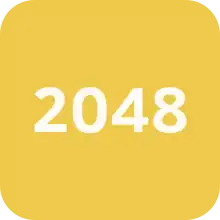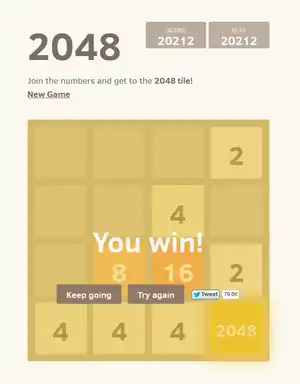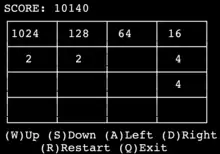2048 (video game)
2048 is a single-player sliding tile puzzle video game written by Italian web developer Gabriele Cirulli and published on GitHub. The objective of the game is to slide numbered tiles on a grid to combine them to create a tile with the number 2048; however, one can continue to play the game after reaching the goal, creating tiles with larger numbers. It was originally written in JavaScript and CSS over a weekend, and released on 9 March 2014 as free and open-source software subject to the MIT License. Versions for iOS and Android followed in May 2014.
| 2048 | |
|---|---|
 App icon | |
| Developer(s) | Gabriele Cirulli |
| Platform(s) | iOS, Nintendo 3DS, Android, Apple TV, KaiOS, Teslatari |
| Release | Web: 9 March 2014[1] |
| Genre(s) | Puzzle |
| Mode(s) | Single-player |
2048 was intended to be an improved version of the iOS game Threes which was released a month earlier. Cirulli himself described 2048 as being "conceptually similar" to Threes. The release of 2048 resulted in the rapid appearance of many similar games, akin to the flood of Flappy Bird variations from 2013. The game received generally positive reviews from critics, with it being described as "viral" and "addictive".
Gameplay

2048 is often played on a plain 4×4 grid, with numbered tiles that slide when a player moves them using the four arrow keys.[2] Every turn, a new tile randomly appears in an empty spot on the board with a value of either 2 or 4.[3] Tiles slide as far as possible in the chosen direction until they are stopped by either another tile or the edge of the grid. If two tiles of the same number collide while moving, they will merge into a tile with the total value of the two tiles that collided.[4][5] The resulting tile cannot merge with another tile again in the same move. Higher-scoring tiles emit a soft glow,[3] and the highest possible tile is 131,072.[6]
If a move causes three consecutive tiles of the same value to slide together, only the two tiles farthest along the direction of motion will combine. If all four spaces in a row or column are filled with tiles of the same value, a move parallel to that row/column will combine the first two and last two.[7] A scoreboard on the upper-right keeps track of the user's score. The user's score starts at zero, and is increased whenever two tiles combine, by the value of the new tile.[3]
The game is won when a tile with a value of 2048 appears on the board, hence the name of the game. After reaching the 2048 tile, players can continue to play (beyond the 2048 tile) to reach higher scores.[8][9][10] When the player has no legal moves (there are no empty spaces and no adjacent tiles with the same value), the game ends.[11][12]
Development
Nineteen-year-old Gabriele Cirulli created the game in a single weekend as a test to see if he could program a game from scratch.[13] It was based on the iOS game Threes, with Cirulli describing it as being "conceptually similar" to Threes.[11][14] James Vincent of The Independent called 2048, "a clone of a clone".[15] Cirulli was surprised when his game received over 4 million visitors in less than a week,[2] especially since it was just a weekend project.[16] "It was a way to pass the time", he said.[17] The game is free to play, Cirulli having said that he was unwilling to make money "from a concept that [he] didn't invent".[18] He released an app version of the game for iOS and Android in May 2014.[19]
Cirulli described 2048 as a clone of an earlier game called 1024.[20] 1024 was itself a clone of the recently released game Threes. In April 2014, Pocket Gamer reported that 15 new clones of Threes were released daily in the App Store.[21] When asked if he was concerned that his situation would end up as stressed as that of Nguyễn Hà Đông, the creator of Flappy Bird, Cirulli said that he had "already gone through that phase" on a smaller scale, and that once he had decided against monetizing 2048, he "stopped feeling awkward."[11]
Adaptations
The simple controls allowed it to be used in a promo video for the Myo gesture control armband,[22] and the availability of the code underneath allowed it to be used as a teaching aid for programming.[23] The second-place winner of a coding contest at Matlab Central Exchange was an AI system that would play 2048 on its own.[24] As the source code is available, many additions to the original game, including a score leaderboard, an undo feature, and improved touchscreen playability have been written by other people. All are available to the public.[2][23]
Spinoffs have been released online and include versions with elements from the Doge meme, Doctor Who, Flappy Bird and Tetris. There have also been a 3D version[25] and versions with bigger or smaller grids.[5] Cirulli sees these spinoffs as "part of the beauty of open source software"[4] and does not object to them "as long as they add new, creative modifications to the game".[26] In 2014, an unofficial clone of the game was published in the iOS app store by Ketchapp, monetized with advertising.[27] There has also been a Doctor Who spinoff of the game,[28] as well as one for the Nintendo 3DS, which included a retail release.[29]
Reception
The game has been described by the Wall Street Journal as "almost like Candy Crush for math geeks",[4] and Business Insider called it "Threes on steroids".[1] Caitlin Dewey of The Washington Post called it "a nerdy, minimalist, frustrating game",[9] while The Independent called it "addictive".[15] The phenomenon of 2048 has been compared to that of Flappy Bird by several commentators. Both games' success, and their simplicity, led to the rapid creation of many variants, and both games have been described as "viral" and "very addictive".[30]
References
- Dickey, Megan Rose (23 March 2014). "Puzzle Game 2048 Will Make You Forget Flappy Bird Ever Existed". Business Insider. Retrieved 27 March 2014.
- Spence, Peter (17 March 2014). "How One 19 Year Old Won the Internet with Addictive Puzzler 2048". City A.M.
- Rodriguez, Salvador (24 March 2014). "Move over Flappy Bird: The latest gaming craze is 2048". Los Angeles Times.
- Ballard, Ed (18 March 2014). "Want to Stay Anonymous? Don't Make a Hit Computer Game". The Wall Street Journal.
- Jon Chang (24 March 2014). "'2048' Is the Next Mobile Game to Eat Up Your Time". ABC News. Retrieved 27 March 2014.
- Neller, Todd W. (2015). "Pedagogical Possibilities for the 2048 Puzzle Game". Journal of Computing Sciences in Colleges. 30 (3): 38–46 [39].
- Price, Rob (2 March 2020). "This hyper-addictive math game is driving the Internet insane". Daily Dot. Retrieved 25 January 2021.
- Kharpal, Arjun (26 March 2014). "19-Year-Old Makes Viral Game Hit in a Weekend". CNBC. Retrieved 8 April 2014.
- Dewey, Caitlin (23 April 2014). "Everything you ever wanted to know about 2048, the Internet's latest impossible hit game". Washington Post. Retrieved 25 January 2021.
- Statt, Nick (22 March 2014). "2048 starts easy; gets hard. Here's how to make it easy again". CNet. Retrieved 25 January 2021.
- Ferri-Benedetti, Fabrizio (26 March 2014). "The creator of 2048 tells us the secret behind the game's success". Softonic. Retrieved 13 November 2020.
- Hartmans, Avery (18 January 2018). "How to play '2048,' the addicting smartphone game Travis Kalanick is obsessed with". Business Insider. Retrieved 25 January 2021.
- Rodriguez, Salvador (27 March 2014). "2048: The new app everyone's talking about". Los Angeles Times. Retrieved 13 April 2014.
- Hern, Alex (31 March 2014). "'Threes is the reason 2048 exists' - game creators hit out at clone". The Guardian. Retrieved 25 January 2021.
- Vincent, James (21 March 2014). "2048: How to play the addictive successor to the Flappy Bird game". The Independent. Archived from the original on 28 March 2014. Retrieved 28 March 2014.
- Rodriguez, Salvador (27 March 2014). "Maker of Hit Puzzle Game '2048' Says He Created It over a Weekend". Los Angeles Times. Retrieved 27 March 2014.
- Kharpal, Arjun (26 March 2014). "19-Year-Old Makes Viral Game Hit in a Weekend". CNBC. Retrieved 8 April 2014.
- Reinsberg, Hillary (18 March 2014). "Why This Free Puzzle Game Is The Most Addictive Thing On The Internet". Buzzfeed News. Retrieved 13 November 2020.
- "2048, success and me — Gabriele Cirulli". Archived from the original on 17 May 2014. Retrieved 16 May 2014.
- Kharpal, Arjun (26 March 2014). "19-year-old makes viral game hit in a weekend". CNBC. Retrieved 26 January 2021.
- Brown, Mark (7 April 2014). "There are 15 new Threes! / 2048 clones released on the App Store every day". Pocket Gamer.
- Etherington, Darrell (24 March 2014). "Watch The Myo Armband Make One 2048 Addict Feel like He's 'A Part' of The Game". TechCrunch. Retrieved 25 March 2014.
- Brown, Andy & Spikes, Sarah. "Make Your Own 2048". Udacity. Retrieved 7 April 2014.
- "2048 Game Solver". The MathWorks, Inc. Retrieved 6 May 2014.
- Perez, Sarah (24 March 2014). "Clones, Clones Everywhere – '1024,' "2048' and Other Copies of Popular Paid Game 'Threes' Fill The App Stores". Techcrunch. Retrieved 25 March 2014.
- Graham, Jefferson (28 March 2014). "2048: The new app everyone's talking about". USA Today. Retrieved 30 March 2014.
- Patrick Klepek (30 April 2015). "The Messy Story Behind A Game Clone". Kotaku. Retrieved 28 January 2021.
- Fullerton, Huw (30 July 2020). "Doctor Who fans are losing their minds over the new 'Thirteen' Doctors game". Radio Times. Retrieved 25 January 2021.
- Schreier, Jason (19 June 2014). "Clone of Clone of Clone Now on 3DS eShop". Kotaku. Retrieved 19 September 2014.
- Rodriguez, Salvador (24 March 2014). "Move over Flappy Bird: The latest gaming craze is 2048". Los Angeles Times. Retrieved 21 November 2014.
